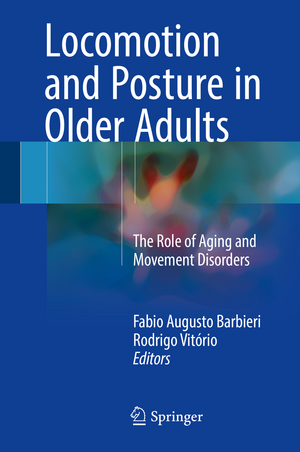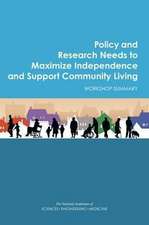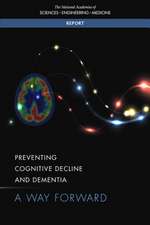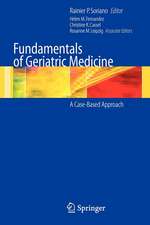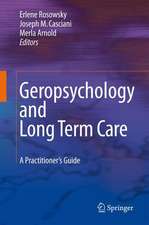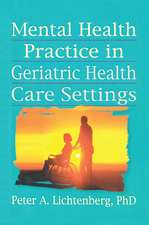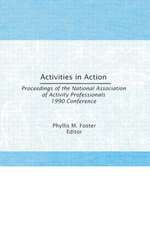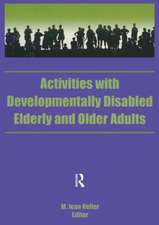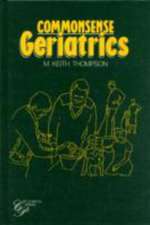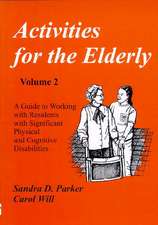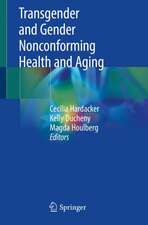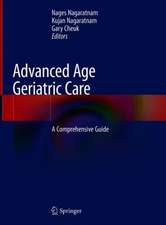Locomotion and Posture in Older Adults: The Role of Aging and Movement Disorders
Editat de Fabio Augusto Barbieri, Rodrigo Vitórioen Limba Engleză Hardback – 17 feb 2017
This book is an attempt to advance the discussion and improve our understanding about the effects of aging and movement disorders on motor control during walking and postural tasks. Despite these activities are performed daily, there is a high requirement of motor and neural systems in order to perform both tasks efficiently. Both walking and posture require a complex interaction of musculoskeletal and neural systems. However, the mechanisms used to control these tasks, as well as how they are planned and coordinated, are still a question of discussion among health professionals and researchers. In addition, this discussion is more interesting when the effects of aging are included in the context of locomotion and the postural control. The number of older individuals is 841 million in 2015, which is four times higher than the 202 million that lived in 1950. Aging causes many motor, sensorial and neural deficits, which impair locomotion and postural control in the elderly. The severity of this framework is worsened when the aging goes along with a movement disorder, such as Parkinson disease, Chorea, Dystonia, Huntington disease, etc.
Therefore, the aim of this book is to highlight the influence of different aspects on planning, controlling and performing locomotion and posture tasks. In attempting to improve current knowledge in this field, invited authors present and discuss how environmental, sensorial, motor, cognitive and individual aspects influence the planning and performance of locomotor and postural activities. The major thrust of the book is to address the mechanisms involved in controlling and planning motor action in neurological healthy individuals, as well as in those who suffer from movement disorders or face the effects of aging, indicating the aspects that impair locomotion and postural control. In addition, new technologies, tools and interventions designed to manage the effects of aging and movement disorders arepresented in the book.
| Toate formatele și edițiile | Preț | Express |
|---|---|---|
| Paperback (1) | 757.92 lei 39-44 zile | |
| Springer International Publishing – 4 mai 2018 | 757.92 lei 39-44 zile | |
| Hardback (1) | 1063.30 lei 39-44 zile | |
| Springer International Publishing – 17 feb 2017 | 1063.30 lei 39-44 zile |
Preț: 1063.30 lei
Preț vechi: 1119.27 lei
-5% Nou
Puncte Express: 1595
Preț estimativ în valută:
203.47€ • 217.57$ • 169.64£
203.47€ • 217.57$ • 169.64£
Carte tipărită la comandă
Livrare economică 14-19 aprilie
Preluare comenzi: 021 569.72.76
Specificații
ISBN-13: 9783319489797
ISBN-10: 3319489798
Pagini: 600
Ilustrații: XVII, 457 p. 41 illus., 21 illus. in color.
Dimensiuni: 155 x 235 x 27 mm
Greutate: 1.04 kg
Ediția:1st ed. 2017
Editura: Springer International Publishing
Colecția Springer
Locul publicării:Cham, Switzerland
ISBN-10: 3319489798
Pagini: 600
Ilustrații: XVII, 457 p. 41 illus., 21 illus. in color.
Dimensiuni: 155 x 235 x 27 mm
Greutate: 1.04 kg
Ediția:1st ed. 2017
Editura: Springer International Publishing
Colecția Springer
Locul publicării:Cham, Switzerland
Cuprins
Part I. Background concepts to motor control in aging and movement disorders.- Chapter 1. Complex systems approach to the study of posture and locomotion in older people.- Chapter 2. Clinical aspects of movement disorders: effects on walking and posture.- Chapter 3. Neuropsychological aspects of movement disorders.- Part II. Walking.- Chapter 4. Stability on walking in neurological healthy individuals.- Chapter 5. Visual control of adaptive locomotion and changes due to natural ageing. - Chapter 6. The walking ability in healthy older adults: The role of aging and physical activity and its interface with agility, balance, cognition and risk of falls.- Chapter 7. Cognition, gait disorders and fall risk in healthy neurological older individuals.- Chapter 8. Visual control of locomotion in people with Parkinson’s disease.- Chapter 9. Gait disturbances in movement disorders: a motor-cognitive problem.- Chapter 10. The influence of muscle fatigue on walking during aging and in individuals with movement disorders.- Chapter 11. Parkinson disease and gait asymmetry.- Chapter 12. Effects of physical activity on walking in individuals with movement disorders.- Part III. Posture.- Chapter 13. Older adults are incapable of changing sensory-motor coupling during upright stance with visual manipulation and different attentional demands.- Chapter 14. Contribution of fingertip light touch on postural stabilization of older adults.- Chapter 15. Effects of vision on postural control in neurological healthy individuals. Chapter 16. Balance control in older adults.- Chapter 17. Association between fall risk and postural instability in the elderly.- Chapter 18. Exercise to maximize postural control and reduce the risk of falls in older age.- Chapter 19. The role of aging and movement disorders on postural control asymmetry.- Chapter 20. Postural control and somatosensory information: effects of aging and Parkinson’s disease.- Chapter 21. Exercise and balance in older adults withmovement disorders.- Part IV. Technology and rehabilitation applied to locomotion and posture.- Chapter 22. Gait initiation in the elderly: concepts, clinical implications and methodology.- Chapter 23. Contribution of virtual reality (Nintendo WII) for exercise training and rehabilitation.- Chapter 24. Deep brain stimulation in Parkinson’s disease: effects on gait and postural control.- Chapter 25. Using virtual reality to advance the understanding and rehabilitation of gait impairments in Parkinson’s disease.- Chapter 26. The applicability of inertial motion sensors for locomotion and posture.- Chapter 27. Age-related changes in the neural control of standing balance.
Recenzii
“Given the morbidity and mortality that accompany gait dysfunction, this is an important book for anyone caring for an individual with locomotion or postural disorders. … The audience is anyone with an interest in posture and gait research or therapeutic interventions, from students to researchers to clinicians, who can take the information presented in the book and apply it to daily practice.” (Lauren Vernese, Doody's Book Reviews, January, 2018)
Notă biografică
Fabio Augusto Barbieri: Assistant professor at the Universidade Estadual Paulista (UNESP) - Faculty of Sciences - Department of Physical Education (Bauru, Brazil) and professor of the graduate program in Human Motor Sciences at the UNESP. Physical Education degree (2004) and master degree in Human Motor Sciences (2007) by the UNESP. PhD in Human Motor Sciences by the UNESP (2012) and PhD in Human Movement Science by the Vrije University (Amsterdam, the Netherlands – 2013). Postdoctoral fellowship in Physical Education at the UNESP (2015). Main research interests are aimed at understanding the biomechanics and motor control of human movement, mainly walking and posture, in healthy individuals and people with neurodegenerative disorders such as Parkinson disease.
Rodrigo Vitório: Postdoctoral Fellow and professor of the graduate program in Human Movement Science at Universidade Estadual Paulista – UNESP (Rio Claro, Brazil). Bachelor in Physical Education (2006), Master of Science (2009) and Ph.D. (2015) in Human Movement Science. Has worked as Research Assistant at the Movement Disorders Research and Rehabilitation Centre at Wilfrid Laurier University (Waterloo, Canada – 2013). Main research interests are focused on (i) how visual information is used for the control of locomotion in patients with Parkinson’s disease; (ii) how Parkinson’s disease and its progression affect the ability to avoid obstacles while walking; (iii) the prediction of falls in patients with Parkinson’s disease and older adults.
Rodrigo Vitório: Postdoctoral Fellow and professor of the graduate program in Human Movement Science at Universidade Estadual Paulista – UNESP (Rio Claro, Brazil). Bachelor in Physical Education (2006), Master of Science (2009) and Ph.D. (2015) in Human Movement Science. Has worked as Research Assistant at the Movement Disorders Research and Rehabilitation Centre at Wilfrid Laurier University (Waterloo, Canada – 2013). Main research interests are focused on (i) how visual information is used for the control of locomotion in patients with Parkinson’s disease; (ii) how Parkinson’s disease and its progression affect the ability to avoid obstacles while walking; (iii) the prediction of falls in patients with Parkinson’s disease and older adults.
Textul de pe ultima copertă
This book is an attempt to advance the discussion and improve our understanding about the effects of aging and movement disorders on motor control during walking and postural tasks. Despite these activities are performed daily, there is a high requirement of motor and neural systems in order to perform both tasks efficiently. Both walking and posture require a complex interaction of musculoskeletal and neural systems. However, the mechanisms used to control these tasks, as well as how they are planned and coordinated, are still a question of discussion among health professionals and researchers. In addition, this discussion is more interesting when the effects of aging are included in the context of locomotion and the postural control. The number of older individuals is 841 million in 2015, which is four times higher than the 202 million that lived in 1950. Aging causes many motor, sensorial and neural deficits, which impair locomotion and postural control in the elderly. The severity of this framework is worsened when the aging goes along with a movement disorder, such as Parkinson disease, Chorea, Dystonia, Huntington disease, etc.
Therefore, the aim of this book is to highlight the influence of different aspects on planning, controlling and performing locomotion and posture tasks. In attempting to improve current knowledge in this field, invited authors present and discuss how environmental, sensorial, motor, cognitive and individual aspects influence the planning and performance of locomotor and postural activities. The major thrust of the book is to address the mechanisms involved in controlling and planning motor action in neurological healthy individuals, as well as in those who suffer from movement disorders or face the effects of aging, indicating the aspects that impair locomotion and postural control. In addition, new technologies, tools and interventions designed to manage the effects of aging and movement disorders are presented in the book.
Caracteristici
The first book to address the role of aging and movement disorders on motor control, especially on walking and posture Multidisciplinary approach about the effects of aging and movement disorders on locomotion and posture Knowledge applicable in everyday life of elderly with and without movement disorders, helping in rehabilitation and physical intervention with this population The book discusses the mechanisms for control, planning and motor action that impair the walking and postural control related to aging and movement disorders Includes supplementary material: sn.pub/extras
